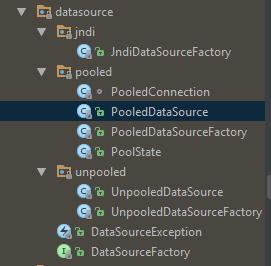Mybatis深入之DataSource实例化过程
简介
主要介绍Mybatis启动过程中DataSource实例化的过程、为后面解析一个完整SQL执行过程做个前章。
Mybatis中DataSource体系
MybatisDataSource整体简介
Mybatis中关于数据库的类都在org.apache.ibatis.datasource包中
Mybatis配置文件中关于数据库的配置:
<environmentsdefault="development"><environmentid="development"><transactionManagertype="JDBC"/><dataSourcetype="POOLED"><propertyname="driver"value="${jdbc.driverClassName}"/><propertyname="url"value="${jdbc.url}"/><propertyname="username"value="${jdbc.username}"/><propertyname="password"value="${jdbc.password}"/></dataSource></environment></environments>- 重点关注
<dataSource type="POOLED">的type属性、其有三种取值:- POOLED:使用Mybatis自带的数据库连接池来管理数据库连接
- UNPOOLED:不使用任何数据库连接池来管理数据库连接
- JNDI:jndi形式使用数据库连接、主要用于项目正常使用的时候
类与类之间的关系:
每一条线都是一种关系、简单解释一下
1. PooledDataSource实现java.sql.DataSource接口
2. PooledDataSource内部持有一个DataSource引用
3. UnpooledDataSource实现java.sql.DataSource接口
4. PooledDataSource内部持有一个UnpooledDataSource引用
5.PooledDataSourceFactory无参构造方法体中将其父类UnpooledDataSourceFactory持有的引用DataSource实例化为PooledDataSource
6. PooledDataSourceFactory继承UnpooledDataSourceFactory
7. UnpooledDataSourceFactory无参构造方法将其持有的引用DataSource实例化为UnpooledDataSource
8. UnpooledDataSourceFactory持有一个DataSource引用、用于返回实例化好的DataSource。
Mybatis中DataSource实例化整体过程
这里以使用Mybatis自带的数据库连接池为例。也就是type为 “POOLED”类型的数据连接。
- 根据配置文件中type的类型实例化具体的DataSourceFactory。这里是POOLED所以实例化的是PooledDataSourceFactory。
- 通过PooledDataSourceFactory来获取DataSource具体实例:PooledDataSource
对于第一步更详细点的过程:
- 在Mybatis初始化Configuration对象时、Configuration中属性TypeAliasRegistry同样被实例化、并且在Configuration的无参构造方法中对TypeAliasRegistry注册了许多常用的类(以键值对的形式保存在TypeAliasRegistry的属性
private final Map<String, Class<?>> TYPE_ALIASES = new HashMap<String, Class<?>>();中、也包括TypeAliasRegistry无参构造方法注册的基本java类型。 - 通过配置文件中type指定的”POOLED”在TypeAliasRegistry中查找其对应的类:PooledDataSourceFactory
- 调用其newInstance()实例化
- PooledDataSourceFactory继承自UnpooledDataSourceFactory、所以UnpooledDataSourceFactory先被实例化、
- UnpooledDataSourceFactory无参构造方法中实例化了其DataSource引用为UnpooledDataSource。
- 接着实例化PooledDataSourceFactory、其无参构造方法体将父类UnpooledDataSourceFactory持有的DataSource实例化为PooledDataSource。
- PooledDataSource实例化时初始化了一些关于数据库连接池的配置信息
- PooledDataSource的无参构造方法中将其持有的UnpooledDataSource实例化。
- UnpooledDataSource中关于数据库连接的属性值在实例化DataSourceFactory之后读取properties值设置到对应属性上。
具体过程
从上一篇中知道Mybatis初始化过程是解析Mybatis配置文件并装配Configuration对象。从Mybatis基础使用中知道Mybatis数据库连接信息的配置是在environments标签中配置的:
<environmentsdefault="development"><environmentid="development"><transactionManagertype="JDBC"/><dataSourcetype="POOLED"><propertyname="driver"value="${jdbc.driverClassName}"/><propertyname="url"value="${jdbc.url}"/><propertyname="username"value="${jdbc.username}"/><propertyname="password"value="${jdbc.password}"/></dataSource></environment></environments>所以想要了解DataSource初始化过程可以从XMLConfigBuilder中的parse方法入手:
privatevoidenvironmentsElement(XNode context)throws Exception {if (context !=null) {if (environment ==null) {
environment = context.getStringAttribute("default");
}for (XNode child : context.getChildren()) {
String id = child.getStringAttribute("id");if (isSpecifiedEnvironment(id)) {
TransactionFactory txFactory = transactionManagerElement(child.evalNode("transactionManager"));
DataSourceFactory dsFactory = dataSourceElement(child.evalNode("dataSource"));
DataSource dataSource = dsFactory.getDataSource();
Environment.Builder environmentBuilder =new Environment.Builder(id)
.transactionFactory(txFactory)
.dataSource(dataSource);
configuration.setEnvironment(environmentBuilder.build());
}
}
}
}- 这里同样有关于数据库事务的配置、具体事务有关的后面再说
主要看如何实例化DataSource、同样从上面代码中我们知道只是将DataSource实例化了而没有进行任何操作、原因是只有具体执行某SQL语句的时候才会使用DataSource来获取数据库连接。
获取DataSource关键代码:
DataSourceFactory dsFactory = dataSourceElement(child.evalNode("dataSource"));
DataSource dataSource = dsFactory.getDataSource();- 根据配置文件中dataSource标签中内容实例化DataSourceFactory
- 通过DataSourceFactory获取DataSource
下面首先看如何根据dataSource标签内容实例化DataSourceFactory
private DataSourceFactorydataSourceElement(XNode context)throws Exception {if (context !=null) {//获取数据库连接池类型: POOLED-使用Mybatis自带数据库连接池。UNPOOL-不使用数据库连接池。这里看POOLED的情况。
String type = context.getStringAttribute("type");
Properties props = context.getChildrenAsProperties();
DataSourceFactory factory = (DataSourceFactory) resolveClass(type).newInstance();
factory.setProperties(props);return factory;
}thrownew BuilderException("Environment declaration requires a DataSourceFactory.");
}- 上面一段代码关键点在于
resolveClass(type) - 经过一系列的方法调用、最终返回结果的方法是:
TypeAliasRegistry
@SuppressWarnings("unchecked")// throws class cast exception as well if types cannot be assignedpublic <T> Class<T>resolveAlias(Stringstring) {try {if (string ==null)returnnull;
String key =string.toLowerCase(Locale.ENGLISH);// issue #748
Class<T>value;if (TYPE_ALIASES.containsKey(key)) {value = (Class<T>) TYPE_ALIASES.get(key);
}else {value = (Class<T>) Resources.classForName(string);
}returnvalue;
}catch (ClassNotFoundException e) {thrownew TypeException("Could not resolve type alias '" +string +"'. Cause: " + e, e);
}
}- 这里重点在于TypeAliasRegistry是何时实例化的
- 上一篇初始化过程中知道Configuration中有一个私有变量
protected final TypeAliasRegistry typeAliasRegistry = new TypeAliasRegistry(); - 进一步看看Configuration实例化的时候其无参构造函数体就知道其缘由
- 上一篇初始化过程中知道Configuration中有一个私有变量
public Configuration() {
typeAliasRegistry.registerAlias("JDBC", JdbcTransactionFactory.class);
typeAliasRegistry.registerAlias("MANAGED", ManagedTransactionFactory.class);
typeAliasRegistry.registerAlias("JNDI", JndiDataSourceFactory.class);
typeAliasRegistry.registerAlias("POOLED", PooledDataSourceFactory.class);
typeAliasRegistry.registerAlias("UNPOOLED", UnpooledDataSourceFactory.class);
typeAliasRegistry.registerAlias("PERPETUAL", PerpetualCache.class);
typeAliasRegistry.registerAlias("FIFO", FifoCache.class);
typeAliasRegistry.registerAlias("LRU", LruCache.class);
typeAliasRegistry.registerAlias("SOFT", SoftCache.class);
typeAliasRegistry.registerAlias("WEAK", WeakCache.class);
typeAliasRegistry.registerAlias("DB_VENDOR", VendorDatabaseIdProvider.class);
typeAliasRegistry.registerAlias("XML", XMLLanguageDriver.class);
typeAliasRegistry.registerAlias("RAW", RawLanguageDriver.class);
typeAliasRegistry.registerAlias("SLF4J", Slf4jImpl.class);
typeAliasRegistry.registerAlias("COMMONS_LOGGING", JakartaCommonsLoggingImpl.class);
typeAliasRegistry.registerAlias("LOG4J", Log4jImpl.class);
typeAliasRegistry.registerAlias("LOG4J2", Log4j2Impl.class);
typeAliasRegistry.registerAlias("JDK_LOGGING", Jdk14LoggingImpl.class);
typeAliasRegistry.registerAlias("STDOUT_LOGGING", StdOutImpl.class);
typeAliasRegistry.registerAlias("NO_LOGGING", NoLoggingImpl.class);
typeAliasRegistry.registerAlias("CGLIB", CglibProxyFactory.class);
typeAliasRegistry.registerAlias("JAVASSIST", JavassistProxyFactory.class);
languageRegistry.setDefaultDriverClass(XMLLanguageDriver.class);
languageRegistry.register(RawLanguageDriver.class);
}- 从上面可以看出TypeAliasRegistry在实例化之后并初始化了其内部私有变量
private final Map<String, Class<?>> TYPE_ALIASES = new HashMap<String, Class<?>>();来保存一些Type alias(类型别名)供后面程序使用。
从上面代码typeAliasRegistry.registerAlias("POOLED", PooledDataSourceFactory.class);可以看出最后返回的是PooledDataSourceFactory。
publicclassPooledDataSourceFactoryextendsUnpooledDataSourceFactory {publicPooledDataSourceFactory() {this.dataSource =new PooledDataSource();
}
}- PooledDataSourceFactory继承UnpooledDataSourceFactory
其中UnpooledDataSourceFactory拥有一个DataSource的protected级别的属性protected DataSource dataSource;并且其构造函数:
publicUnpooledDataSourceFactory() {this.dataSource =new UnpooledDataSource();
}对比PooledDataSourceFactory的构造函数:
publicPooledDataSourceFactory() {this.dataSource =new PooledDataSource();
}知道最终UnpooledDataSourceFactory的protected DataSource dataSource;实例是:PooledDataSource。
到这里只要知道PooledDataSource是什么、那么返回的DataSource就是什么。
当然在这之前还需要一步、就是将配置文件中的数据库连接信息设置到最后生成的DataSourceFactory(在这里就是PooledDataSourceFactory)中去。这个过程中使用了一个Mybatis很长用的用于操作反射的封装类:MetaObject。提供了一些简便的获取、设置类等通过反射来操作类的方法、以后有时间专门看一眼。
下面的主要目标就是看PooledDataSource调用其无参构造方法时到底做了什么。
PooledDataSource是java.sql.DataSource的一个实现类、其属性与无参构造方法如下:
privatestaticfinal Log log = LogFactory.getLog(PooledDataSource.class);privatefinal PoolState state =new PoolState(this);privatefinal UnpooledDataSource dataSource;// OPTIONAL CONFIGURATION FIELDSprotectedint poolMaximumActiveConnections =10;protectedint poolMaximumIdleConnections =5;protectedint poolMaximumCheckoutTime =20000;protectedint poolTimeToWait =20000;protected String poolPingQuery ="NO PING QUERY SET";protectedboolean poolPingEnabled =false;protectedint poolPingConnectionsNotUsedFor =0;privateint expectedConnectionTypeCode;publicPooledDataSource() {
dataSource =new UnpooledDataSource();
}- 设置了一些作为数据库连接池初始化使用的参数
- 无参方法体中实例话了属性
dataSource = new UnpooledDataSource(); - UnpooledDataSource无参构造函数是空方法题
- 要注意的是:前面实例化DataSourceFactory的时候最后一步是设置属性。其实就是通过MetaObject来将属性值设置到UnpooledDataSource的数据库连接属性上了。
到这里、关于数据库DataSource类的实例话也就结束了。
补充
对数据库实例化做个总结:
当使用数据库连接池时、即<dataSource type="POOLED">时、DataSourceFactory具体实例是PooledDataSourceFactory。返回的DataSource具体实例是内部持有UnpooledDataSource实例的PooledDataSource。
当不使用数据库连接池时、即<dataSource type="UNPOOLED"> 时、DataSourceFactory具体实例是UnpooledDataSourceFactory。返回的DataSource具体实例是UnpooledDataSource实例。
更多内容:Mybatis 目录